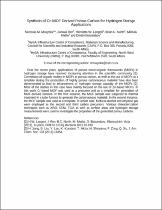JavaScript is disabled for your browser. Some features of this site may not work without it.
- ResearchSpace
- →
- Research Publications/Outputs
- →
- Conference Publications
- →
- View Item
| dc.contributor.author |
Musyoka, Nicholas M

|
|
| dc.contributor.author |
Ren, Jianwei

|
|
| dc.contributor.author |
Langmi, Henrietta W

|
|
| dc.contributor.author |
North, Brian C

|
|
| dc.contributor.author |
Mathe, Mahlanyane K

|
|
| dc.contributor.author |
Bessarabov, D

|
|
| dc.date.accessioned | 2015-02-09T07:27:33Z | |
| dc.date.available | 2015-02-09T07:27:33Z | |
| dc.date.issued | 2014-07 | |
| dc.identifier.citation | Musyoka, N.M., Ren, J., Langmi, H.W., North, B.C., Mathe, M. and Bessarabov, D. 2014. Synthesis of Cr-MOF derived porous carbon for hydrogen storage applications. In: 14th International Symposium on Metal-Hydrogen Systems, Manchester, United Kingdom, 20-25 July 2014 | en_US |
| dc.identifier.uri | http://hdl.handle.net/10204/7857 | |
| dc.description | 14th International Symposium on Metal-Hydrogen Systems, Manchester, United Kingdom, 20-25 July 2014 | en_US |
| dc.description.abstract | Over the recent years, applications of porous metal-organic frameworks (MOFs) in hydrogen storage have received increasing attention in the scientific community. Conversion of organic moiety in MOFs to porous carbon, as well as the use of MOFs as a template during the production of highly porous carbonaceous material have also been demonstrated to lead to enhancement of hydrogen storage capacity of the MOFs. Most of the studies in this case have mainly focused on the use of Zn-based MOFs. In this work Cr-based MOF was used as a precursor and as a template for generation of MOF-derived carbons. In the first instance, the MOF sample was subjected to thermal treatment in a tube furnace to generate the carbonaceous material. In the second instance, the MOF sample was used as a template, in which case, furfural alcohol and ethylene gas were employed as the second and third carbon precursors. Various characterization techniques such as XRD, SEM, TGA as well as surface areas and hydrogen storage measurements were used to investigate the properties of the generated porous carbons. | en_US |
| dc.language.iso | en | en_US |
| dc.relation.ispartofseries | Workflow;14115 | |
| dc.subject | Metal-organic frameworks | en_US |
| dc.subject | MOFs | en_US |
| dc.subject | Hydrogen storage applications | en_US |
| dc.subject | Porous carbon | en_US |
| dc.title | Synthesis of Cr-MOF derived porous carbon for hydrogen storage applications | en_US |
| dc.type | Conference Presentation | en_US |
| dc.identifier.apacitation | Musyoka, N. M., Ren, J., Langmi, H. W., North, B. C., Mathe, M. K., & Bessarabov, D. (2014). Synthesis of Cr-MOF derived porous carbon for hydrogen storage applications. http://hdl.handle.net/10204/7857 | en_ZA |
| dc.identifier.chicagocitation | Musyoka, Nicholas M, Jianwei Ren, Henrietta W Langmi, Brian C North, Mahlanyane K Mathe, and D Bessarabov. "Synthesis of Cr-MOF derived porous carbon for hydrogen storage applications." (2014): http://hdl.handle.net/10204/7857 | en_ZA |
| dc.identifier.vancouvercitation | Musyoka NM, Ren J, Langmi HW, North BC, Mathe MK, Bessarabov D, Synthesis of Cr-MOF derived porous carbon for hydrogen storage applications; 2014. http://hdl.handle.net/10204/7857 . | en_ZA |
| dc.identifier.ris | TY - Conference Presentation AU - Musyoka, Nicholas M AU - Ren, Jianwei AU - Langmi, Henrietta W AU - North, Brian C AU - Mathe, Mahlanyane K AU - Bessarabov, D AB - Over the recent years, applications of porous metal-organic frameworks (MOFs) in hydrogen storage have received increasing attention in the scientific community. Conversion of organic moiety in MOFs to porous carbon, as well as the use of MOFs as a template during the production of highly porous carbonaceous material have also been demonstrated to lead to enhancement of hydrogen storage capacity of the MOFs. Most of the studies in this case have mainly focused on the use of Zn-based MOFs. In this work Cr-based MOF was used as a precursor and as a template for generation of MOF-derived carbons. In the first instance, the MOF sample was subjected to thermal treatment in a tube furnace to generate the carbonaceous material. In the second instance, the MOF sample was used as a template, in which case, furfural alcohol and ethylene gas were employed as the second and third carbon precursors. Various characterization techniques such as XRD, SEM, TGA as well as surface areas and hydrogen storage measurements were used to investigate the properties of the generated porous carbons. DA - 2014-07 DB - ResearchSpace DP - CSIR KW - Metal-organic frameworks KW - MOFs KW - Hydrogen storage applications KW - Porous carbon LK - https://researchspace.csir.co.za PY - 2014 T1 - Synthesis of Cr-MOF derived porous carbon for hydrogen storage applications TI - Synthesis of Cr-MOF derived porous carbon for hydrogen storage applications UR - http://hdl.handle.net/10204/7857 ER - | en_ZA |






